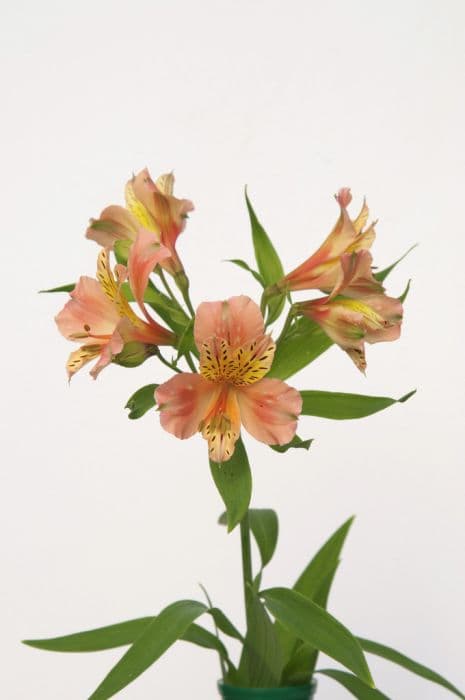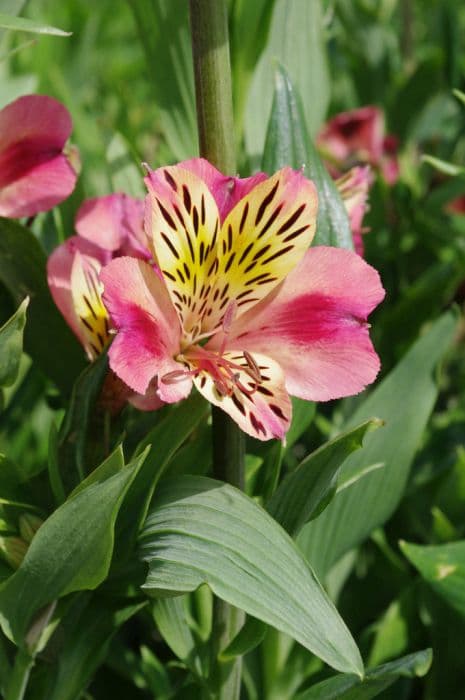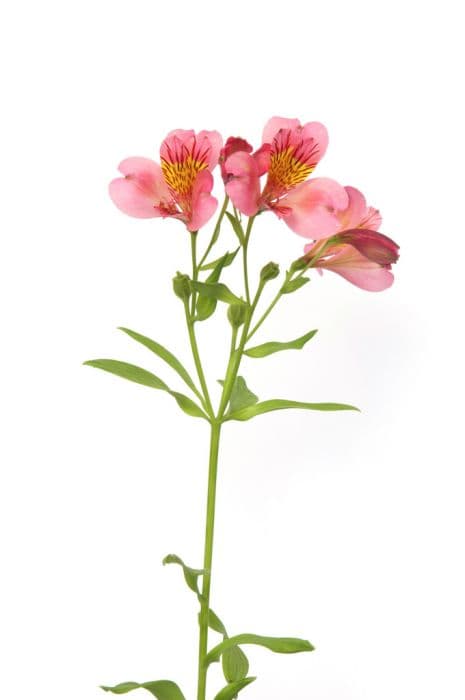Peruvian Lily Alstroemeria Princess Juliana = 'Staterpa' (Princess Series)
![Peruvian lily [Princess Juliana]](/_next/image?url=https%3A%2F%2Fplants-admin.emdemapps.com%2Fimages%2Fplants%2F%2Fimages%2F604b58a412bfb.png&w=3840&q=75)
ABOUT
The Alstroemeria Princess Juliana, part of the Princess Series, is a vibrant and eye-catching flower that boasts a beautiful display of colors. The plant is adorned with stunning trumpet-shaped blossoms that exhibit a warm, golden-yellow hue with contrasting reddish-brown streaks and freckles on the petals, giving them a striking and exotic look. The leaves of the Alstroemeria Princess Juliana grow in an interesting, twisted manner, which adds to the plant's overall visual interest. As a perennial, this Alstroemeria produces a dense cluster of these colorful, lily-like flowers, creating a lush and full appearance that enhances any garden with a continuous flourish of blossoms throughout its blooming season.
About this plant
 Names
NamesSynonyms
Princess Juliana Alstroemeria, Peruvian Lily, Lily of the Incas, Parrot Lily.
Common names
Alstroemeria 'Staterpa'.
 Characteristics
CharacteristicsLife cycle
Perennials
Foliage type
Deciduous
Color of leaves
Green
Flower color
Yellow
Height
1-2 feet (30-60 cm)
Spread
1-2 feet (30-60 cm)
Plant type
Herb
Hardiness zones
7
Native area
South America
Benefits
 General Benefits
General Benefits- Long Blooming Period: Alstroemeria Princess Juliana typically has a prolonged blooming period, providing color from late spring to early autumn.
- Attractive Flowers: It produces eye-catching, trumpet-shaped flowers with striking colors and patterns that can enhance the beauty of any garden.
- Cut Flower Use: The blossoms are excellent for cutting and have a long vase life, making them ideal for floral arrangements.
- Pollinator Friendly: The flowers attract bees, butterflies, and other pollinators, supporting local ecosystems and biodiversity.
- Drought Tolerance: Once established, this plant can tolerate periods of drought, making it suitable for water-wise gardens.
- Low Maintenance: Alstroemeria Princess Juliana is relatively easy to care for, requiring minimal maintenance once it’s well-established.
- Frost Resistance: It has a degree of frost resistance, which allows it to survive in cooler climates and extends its range of cultivation.
- Versatility in Landscaping: It can be used in various landscaping designs, including borders, containers, and as a ground cover.
 Medical Properties
Medical PropertiesThis plant is not used for medical purposes.
 Air-purifying Qualities
Air-purifying QualitiesThis plant is not specifically known for air purifying qualities.
 Other Uses
Other Uses- Photography and Art Subjects: The vibrant colors and intricate patterns of the Peruvian lily make it an excellent subject for photographers and artists looking to capture the beauty of nature.
- Educational Tools: The complex reproductive strategies of Peruvian lilies can be used in educational settings to showcase plant biology and the importance of pollinators in the ecosystem.
- Culinary Garnish: The non-toxic petals of the Peruvian lily can be used as a decorative garnish for upscale culinary dishes, adding a splash of color to the presentation.
- Color Inspiration: The wide range of colors in which Peruvian lilies are available can serve as inspiration for interior designers and decorators.
- Handcrafts: Dried Peruvian lily petals can be used to make eco-friendly, biodegradable confetti or incorporated into paper making for a unique, floral touch.
- Symbolism and Gifts: In the language of flowers, the Peruvian lily signifies friendship and devotion, making them an ideal gift for friends and loved ones on special occasions.
- Phototropic Demonstrations: Peruvian lilies exhibit phototropism, making them useful in demonstrations and experiments showing how plants move towards light.
- Theme Gardens: Peruvian lilies can be used in a South American-themed garden or cultural education program to represent the flora of that region.
- Texture Contrast in Arrangements: The unique texture of Peruvian lily's leaves and stems can be used to add a contrasting touch to floral arrangements and bouquets.
- Seasonal Celebrations: With their winter blooming season, Peruvian lilies can add color and life to celebrations and decorations in the colder months.
Interesting Facts
 Feng Shui
Feng ShuiThe Peruvian Lily is not used in Feng Shui practice.
 Zodiac Sign Compitability
Zodiac Sign CompitabilityThe Peruvian Lily is not used in astrology practice.
 Plant Symbolism
Plant Symbolism- Friendship: Alstroemeria is commonly known as the Peruvian Lily or Lily of the Incas and often symbolizes long-lasting friendship due to its enduring nature and the way its flowers cluster together.
- Devotion: The twists in the flower which cause it to turn towards the sun epitomize the twists, turns, and growth of friendships, symbolizing mutual support and devotion between friends.
- Wealth and Prosperity: With its lush blooms and multiple flowers per stem, the Peruvian Lily is often associated with wealth and prosperity, suggesting an abundance of blessings.
- Achievement: As part of the Princess Series and named 'Princess Juliana', this cultivar specifically carries connotations of nobility and achievement, representing the honor of overcoming challenges.
- Mutual Support: The intertwining leaves of the Alstroemeria symbolize intertwined lives and mutual support between individuals, often used in bouquets to indicate a supportive nature.
 Water
WaterTo properly water the Peruvian Lily, ensure the soil is kept consistently moist but not waterlogged. During the growing season, water the plant thoroughly once a week using about 0.5 to 1 gallon of water each time, depending on the size of the plant and the environmental conditions. In hotter, drier periods, you may need to water twice a week. Ensure that the water penetrates deeply into the soil to encourage deep root growth. Reduce watering in the winter months when the plant is not actively growing, and allow the soil to dry out slightly between waterings.
 Light
LightPeruvian Lilies prefer bright, indirect sunlight. The best spot for this plant is in an area where it can receive plenty of light throughout the day but is shielded from the harsh midday sun. A location near an east or west-facing window is ideal, where it can enjoy the softer morning or late afternoon sun without the risk of scorching its leaves.
 Temperature
TemperaturePeruvian Lilies thrive in temperatures ranging from 65 to 80 degrees Fahrenheit, which are typically considered ideal conditions. They can withstand minor dips down to around 50 degrees Fahrenheit but should be protected from frost. During extreme heat or cold spells, take steps to moderate the environment, as temperatures outside of 50 to 80 degrees Fahrenheit can stress the plant.
 Pruning
PruningPrune Peruvian Lilies to remove faded or dead flowers and to keep the plant looking tidy. This also encourages more blooms. Cut back the flower stalks to the base of the plant after flowering. Pruning is best done in the late fall or early spring before new growth begins. Additionally, remove any damaged or diseased leaves as soon as they are noticed to maintain plant health.
 Cleaning
CleaningAs needed
 Soil
SoilPeruvian Lily requires well-draining soil enriched with organic matter, such as compost or peat moss. The best soil mix might contain two parts loam, one part sand or perlite, and one part organic material. The soil pH should be slightly acidic to neutral, ranging from 6.5 to 7.0 for optimal growth.
 Repotting
RepottingPeruvian Lily should be repotted every two to three years to refresh the soil and accommodate root growth. Carefully lift the plant and increase the pot size if roots have become crowded.
 Humidity & Misting
Humidity & MistingPeruvian Lily thrives best in moderate humidity. Aim for relative humidity levels between 40% and 60% for the healthiest growth, avoiding conditions that are too dry or excessively moist.
 Suitable locations
Suitable locationsIndoor
Place in bright, indirect light, and ensure good air circulation.
Outdoor
Plant in partial shade and shelter from strong winds.
Hardiness zone
7-10 USDA
 Life cycle
Life cycleAlstroemeria Princess Juliana, commonly known as Peruvian Lily or Lily of the Incas, begins its life cycle as a rhizome, a type of underground stem that stores nutrients. Upon planting in well-draining soil with adequate sunlight, the rhizome will sprout and grow into a lush green plant, with leafy stems supporting the growth. As the plant matures, it produces distinctive funnel-shaped flowers, often in vibrant shades of orange, marked with streaks and spots. The blooming phase can occur from late spring to early fall, during which time the plant can be propagated either by division of rhizomes or through seed germination, though the latter is less common with hybrids like the Princess Series. After the flowering period, the plant enters a dormant phase, particularly in colder climates, whereby the foliage may die back, and the rhizome remains dormant until favorable growth conditions return. As a perennial, the Peruvian Lily will reemerge from dormancy in spring to repeat the growth cycle, living for several years with proper care and conditions.
 Propogation
PropogationPropogation time
Spring-Early Summer
Alstroemeria, commonly known as Peruvian Lily or Lily of the Incas, is most commonly propagated through division, which is typically done in the spring. To propagate through division, carefully lift the clump of tubers from the ground after the flowering has finished and the plant has begun to die back. Gently tease apart the individual tubers with your hands or use a sharp knife if necessary, ensuring that each section has at least one eye, which is a growth point where new shoots will emerge. Replant the divisions immediately at the same depth they were growing previously, spacing them about 12 to 24 inches (30 to 60 centimeters) apart to allow for ample growing space. Water the divisions thoroughly after planting to help establish them. This method is effective for increasing your stock of Alstroemeria Princess Juliana and maintaining the health and vigor of your plants by rejuvenating crowded clumps.




![Peruvian lily [Indian summer]](/_next/image?url=https%3A%2F%2Fplants-admin.emdemapps.com%2Fimages%2Fplants%2F%2Fimages%2F604b616bc746b.png&w=640&q=75)
![Peruvian lily [Inticancha Creamy Dark Pink]](/_next/image?url=https%3A%2F%2Fplants-admin.emdemapps.com%2Fimages%2Fplants%2F%2Fimages%2F604b5e98bea7c.png&w=640&q=75)
![Peruvian lily [Inticancha Imala]](/_next/image?url=https%3A%2F%2Fplants-admin.emdemapps.com%2Fimages%2Fplants%2F%2Fimages%2F604b619b522ba.png&w=640&q=75)
![Peruvian lily [Inticancha Red]](/_next/image?url=https%3A%2F%2Fplants-admin.emdemapps.com%2Fimages%2Fplants%2F%2Fimages%2F604b5aebac273.png&w=640&q=75)
![Peruvian lily [Inticancha Sunday]](/_next/image?url=https%3A%2F%2Fplants-admin.emdemapps.com%2Fimages%2Fplants%2F%2Fimages%2F604b646146dd9.png&w=640&q=75)
